![]()
![]()
![]()
Use LEFT and RIGHT arrow keys to navigate between flashcards;
Use UP and DOWN arrow keys to flip the card;
H to show hint;
A reads text to speech;
28 Cards in this Set
- Front
- Back
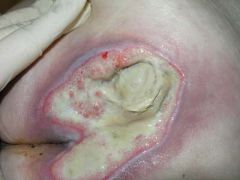
What is the descriptive term for the yellow tissue?
|
Slough
|
|
|
What is the descriptive term for exudate that is clear, thin, and watery?
|
Serous
|
|
|
What is the descriptive term for exudate that is thin, watery, pale red to pink?
|
Serosanguineous
|
|
|
Wound measurements should be recorded in what order?
|
Length X Width X Depth
|
|
|
Wounds should be measured utilizing inches, centimeters, or fruit comparisons?
|
Centimeters
|
|
|
Length of a wound is measured from head to toe (12:00 - 6:00) or side to side (3:00-9:00)?
|
Consider wound as face of clock. 12:00 points to patients head, 6:00 points toward patient’s feet.
Length = 12:00 – 6:00 using patients head & feet as guides Width = 3:00 – 9:00 side to side |
|

What is the correct terminology for the black tissue?
|
Eschar
|
|
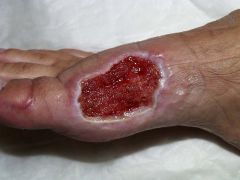
What is the correct terminology for the red bubbly tissue?
|
Granulation
|
|
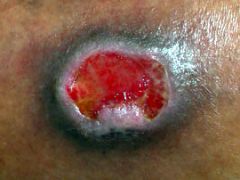
What is the correct terminology for the light pink tissue seen at the edge of this wound?
|
Epithelial
|
|
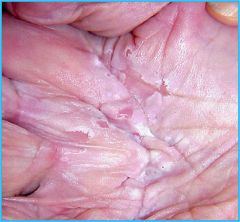
What is the terminology for the white pale tissue?
|
Maceration
|
|

What is the red striated tissue seen in this wound?
|
Muscle
|
|
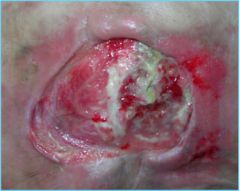
What is the name of the rolled tissue around the wound edges?
|
Epibole
|
|
|
What am I? A course or pathway that can extend in any direction from the wound, results in dead space with potential for abscess formation.
|
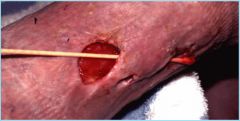
Tunnel
|
|
|
What am I? Tissue destruction underlying intact skin along the wound margins.
|
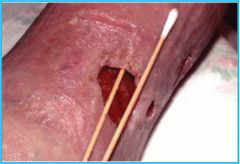
Undermining
|
|
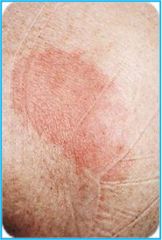
What pressure ulcer stage?
|
Stage I
Intact skin with non-blanchable redness of a localized area usually over a bony prominence |
|
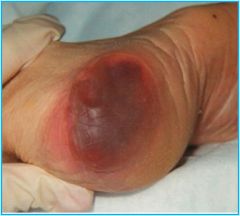
What pressure ulcer stage?
|
Suspected deep tissue injury
Purple or maroon localized area of discolored intact skin or blood-filled blister due to damage of underlying soft tissue from pressure and/or shear. |
|
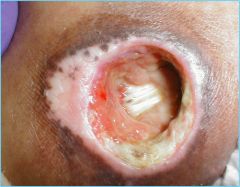
What pressure ulcer stage?
|
Stage IV: Full thickness tissue loss with exposed bone, tendon or muscle. Slough or eschar may be present on some parts of the wound bed. Often include undermining and tunneling.
|
|
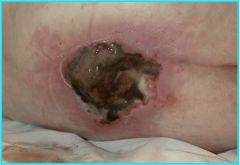
What pressure ulcer stage?
|
Un-stageable: Full thickness tissue loss in which the base of the ulcer is covered by slough (yellow, tan, gray, green or brown) and/or eschar (tan, brown or black) in the wound bed.
|
|
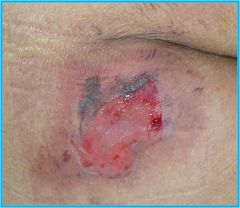
What pressure ulcer stage?
|
Stage II: Partial thickness loss of dermis presenting as a shallow open ulcer with a red pink wound bed, without slough. May also present as an intact or open/ruptured serum-filled blister.
|
|
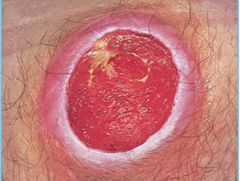
What pressure ulcer stage?
|
Stage III: Full thickness tissue loss. Subcutaneous fat may be visible but bone, tendon or muscle is not exposed. Slough may be present but does not obscure the depth of tissue loss.
|
|
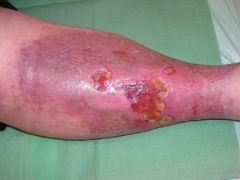
What is the terminology for the brown discoloration around this wound?
|
Hemosiderin staining
Hyper-pigmentation stain of skin from leakage of red blood cells into the tissue (Results from venous hypertension) |
|
|
Where are venous ulcers typically located?
|
Medial lower leg, ankle, malleolar area
|
|
|
What type of wounds are categorized using the Payne-Martin Classification?
|
Skin Tears
|
|
|
What is the Braden Scale used for?
|
Determining pressure ulcer risk
|
|
|
Where are arterial ulcers typically located?
|
Between toes or tips of toes, over phalangeal heads, around lateral malleolus or areas subjected to trauma/rubbing footwear.
|
|
|
What is the anatomical terminology for toward the middle? Away from the middle?
|
Medial - toward middle
Lateral - away from middle |
|
|
How often should wounds be assessed?
|
Upon every dressing change, and documented at least weekly.
|
|
|
Where are neuropathic (diabetic) ulcers typically located?
|
Planter aspect of foot, under metatarsal heads, under heel and toes.
|

